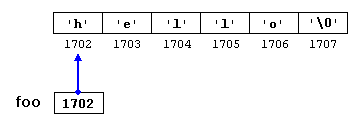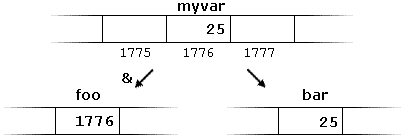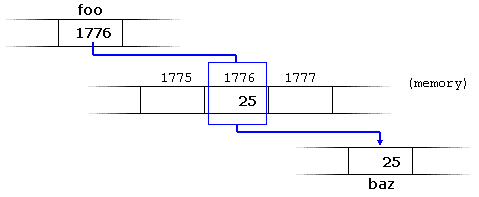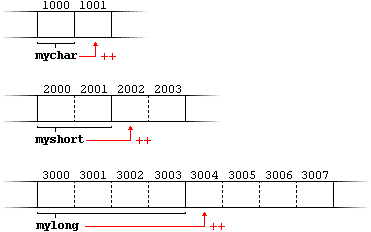資料來源: Cplusplus.com
定义
存儲另一個變量地址的變量被稱為指針。
運算符
- &: address-of operator, 中文譯為“取地址運算符”.
foo = &myvar; myvar的地址就通過'&'+'myvar',被指針foo得到。存儲器中變量的實際地址在執行之前是未知的。但是,我們假設,myvar的地址在程序執行期間為1776.
myvar = 25;
foo = &myvar;
bar = myvar;
- 首先,將數值25賦給myvar。
- 第二个聲明將myvar的地址賦給foo,即為1776(是我們假設的地址)
- 最後一個聲明,將myvar中的值發給了bar。
- *: Dereference operator, 中文譯為“間接運算符”. 指針一個很有意思的性質就是可以被用來直接讀取它們所指的變量。這樣就是通過採用'pointer name'+'*'的形式。
baz = *foo;,可以被解讀為“baz同foo所指向的值相等”
指針聲明
指針在指向不同類型數值的時候擁有不同的屬性。在指針聲明的時候,類型一定要聲明:type * name。同時要注意:聲明中的'*'只是表明是指針,和我們前面所提到的簡潔運算符'*'是不同的。它們雖然標誌是一樣的,但是所代表的意義卻是不同的。
int firstvalue, secondvalue; int * mypointer; mypointer = &firstvalue; *mypointer = 10; mypointer = &secondvalue; *mypointer = 20; cout << "firstvalue is " << firstvalue << '\n'; cout << "secondvalue is " << secondvalue << '\n'; return 0; 這裡面的 ' int * mypointer' 和' *mypointer = 10'中的'*'所代表的意義是不同的。第一個'*'只是表明聲明的為pointer,而第二個則代表mypointer所指向的地址。
下面是一個更加詳細的說明:
#include <iostream> using namespace std; int main () { int firstvalue = 5, secondvalue = 15; int * p1, * p2; p1 = &firstvalue; // p1 = address of firstvalue p2 = &secondvalue; // p2 = address of secondvalue *p1 = 10; // value pointed to by p1 = 10 *p2 = *p1; // value pointed to by p2 = value pointed by p1 p1 = p2; // p1 = p2 (value of pointer is copied) *p1 = 20; // value pointed by p1 = 20 cout << "firstvalue is " << firstvalue << '\n'; cout << "secondvalue is " << secondvalue << '\n'; return 0; } 以上兩個程序的輸出均為:
firstvalue is 10
secondvalue is 20
還有一點要注意,同時聲明兩個指針的時候,需要int *p1, *p2而不能int *p1, p2。後面的聲明是將p2聲明成了整形變量,而非指針。
指針與數組
數據的概念與指針相關。實際上,數據的功能與指向數組的第一個變量的指針非常相像。
int myarray [20] ; int * mypointer ; mypointer = myarray; 執行之後,mypointer和array都會相同,並且有相似的性質。主要的區別是,mypointer可以被賦給其它的地址,但是myarray不能被賦給任何東西,並且總是代表著擁有20個int型的塊(block)。因此myarray = mypointer;是不允許的。
指針與數組的例子如下:
#include <iostream> using namespace std; int main () { int numbers[5]; int * p; p = numbers; *p = 10; p++; *p = 20; p = &numbers[2]; *p = 30; p = numbers + 3; *p = 40; p = numbers; *(p+4) = 50; for (int n=0; n<5; n++) cout << numbers[n] << ", "; return 0; } 輸出為:10, 20, 30, 40, 50,.
並且數據的名字可以用當成指向其第一個數據的指針來使用。
a[5] = 0; // a [offset of 5] = 0
*(a+5) = 0; // pointed by (a+5) = 0
指針的初始化
指針可以初始化為指向一個特定地址的指針。
int myvar; int * myptr = &myvar; int myvar; int * myptr; myptr = &myvar; 指針初始化的時候,初始化的是指針所指向的地址(myptr),而不是所指向的值(*myptr),因此下面的聲明是錯誤的:
int myvar; int * myptr; *myptr = &myvar; 同時,指針可以被初始化為變量地址,也可以初始化為另一個指針或是數組的值。
int myvar; int *foo = &myvar; int *bar = foo; 指針計算
指針計算同數值計算有些不同。只有加法和減法的運算被允許。而其他運算在指針的世界并沒有多大的意義。但是由於指針所屬的類型不同,指針的加減法也有一些差異。
首先定義三個指針:
char *mychar; short *myshort; long *mylong; 並且(假設)我們知道它們所指的存儲器的位置分別為1000,2000,3000.因此,當我們執行:
++mychar;
++myshort;
++mylong;
之後,指針所知的位置的實際增加卻是不一樣的。因此sizeof(char)為1,sizeof(short)為2,sizeof(long)為8,因此結果如圖所示:
注意: mylong應該指向3008
指針運算一些例子如下:
*p++ // same as *(p++): increment pointer, and dereference unincremented address *++p // same as *(++p): increment pointer, and dereference incremented address ++*p // same as ++(*p): dereference pointer, and increment the value it points to (*p)++ // dereference pointer, and post-increment the value it points to 注意'++'比'*'擁有更高的運算等級。
指針與常量(const)
指針可以通過地址來讀取一個變量,並且讀取可以包括改變所指的數值。同時,我們也可以聲明只可以讀取所指數值但不能改變數值的指針。這裡,就需要是使用const來幫助:
int x; int y = 10; const int * p = &y; x = *p; // ok: reading p *p = x; // error: modifying p, which is const-qualified 可以通過指針p來讀取y的值,但是卻不能改變所指向的值。
// pointers as arguments: #include <iostream> using namespace std; void increment_all (int* start, int* stop) { int * current = start; while (current != stop) { ++(*current); // increment value pointed ++current; // increment pointer } } void print_all (const int* start, const int* stop) { const int * current = start; while (current != stop) { cout << *current << '\n'; ++current; // increment pointer } } int main () { int numbers[] = {10,20,30}; increment_all (numbers,numbers+3); print_all (numbers,numbers+3); return 0; } 輸出為:
11
21
31
注意到,指針指向的內容不能被改變,但是指針本身確實可以改變的,++ current。
還有其他關於常量指針的應用:
int x; int * p1 = &x; // non-const pointer to non-const int const int * p2 = &x; // non-const pointer to const int int * const p3 = &x; // const pointer to non-const int const int * const p4 = &x; // const pointer to const int const int * p2a = &x; // non-const pointer to const int int const * p2b = &x; // also non-const pointer to const int 在具體使用中,可以更加深入體會常量指針的用處。
指針和字符串
不含空格終止的字符序列所組成的數組成為字符串。字符串也可以直接被指針所讀取。字符串的聲明為: const char * foo = "hello";(作為字符串,他們不能被修改) 
要注意到: foo 是一個指針,並且包含地址值 1702,不是'h',也不是'hello',儘管1702實際是'h'和'hello'的地址。
*(foo+4)
foo[4]
這兩個聲明均為 'o'。
指向指針的指針
C++允許指向指針的指針的使用。
char a; char * b; char ** c; a = 'z'; b = &a; c = &b; 變量的地址值均為假設值:
- c is of type char** and a value of 8092
- *c is of type char* and a value of 7230
- **c is of type char and a value of 'z'
空指針(void pointer)
void型是指針的一個特殊類型。在C++中,代表此指針類型的空缺。因此,void型指針是指向沒有類型的數值的指針。
雖然void指針有很大的彈性,可以指向任何數據類型。但同時,也有一些限制,它們所指向的數據不能被直接dereference。因此,void指針的地址需要被轉換到它所指向數據的類型,才能夠被dereference.
#include <iostream> using namespace std; void increase (void* data, int psize) { if ( psize == sizeof(char) ) { char* pchar; pchar=(char*)data; ++(*pchar); } else if (psize == sizeof(int) ) { int* pint; pint=(int*)data; ++(*pint); } } int main () { char a = 'x'; int b = 1602; increase (&a,sizeof(a)); increase (&b,sizeof(b)); cout << a << ", " << b << '\n'; return 0; } 輸出為y, 1063。
無效指針與空指針(Invalid pointers and null pointers)
指針可以指向任何地址,包括沒有任何有效元素的地址。
int * p; // uninitialized pointer (local variable) int myarray[10]; int * q = myarray+20; // element out of bounds 指針P為指向任何地址,指針q指向不存在元素的地址。但是上面的聲明均沒有出現錯誤。在C++中,指針可被存在賦予任何地址值,不論這個地址上是否存在元素。但是,讓dereference這樣一個指針(實際上市他們所指的值),程序就會出現錯誤。讀取這樣一個指針會引用異常行為。
同時,有些時候,指針需要表明不指向任何地址,或一個無效的地址。
int * p = 0; int * q = nullptr; p和q均為空指針,實際上,它們是相等的。早期的代碼也這樣定義int * r = NULL;。
不要將null pointer與void pointer搞混。
- A null pointer is a value that any pointer can take to represent that it is pointing to "nowhere". It refers to the value stored in the pointer.
- A void pointer is a type of pointer that can point to somewhere without a specific type. It refers to the type of data it points to.
指向函數的指針
#include <iostream> using namespace std; int addition (int a, int b) { return (a+b); } int subtraction (int a, int b) { return (a-b); } int operation (int x, int y, int (*functocall)(int,int)) { int g; g = (*functocall)(x,y); return (g); } int main () { int m,n; int (*minus)(int,int) = subtraction; m = operation (7, 5, addition); n = operation (20, m, minus); cout <<n; return 0; } 輸出為: 8.
其中,minus是指向函數的指針,這個函數擁有兩個int型的變量。
初始化:int (* minus)(int,int) = subtraction;



